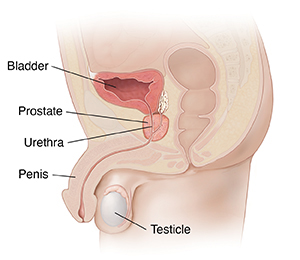
According to the Centers for Disease Control (CDC), aside from non-melanoma skin cancer, prostate cancer is the most common cancer among men in the United States. The American Cancer Society says, “About 1 in 8 men will be diagnosed with prostate cancer during their lifetime. But each man’s risk of prostate cancer can vary based on his age, race/ethnicity, and other factors.”
In recognition of Prostate Cancer Awareness Month, we’re looking at prostate cancer screening, what it entails, and things to talk with your primary care provider or urologist about.
Should I get screened for prostate cancer?
Talk with your provider. You and your provider can discuss your personal risk factors, the benefits and harms of screening, and, if screening is recommended, which screening is best for you. In 2018, the U.S. Preventive Services Task Force (USPSTF) recommended men aged 55 to 69 benefit most from a prostate screening test. This recommendation is currently under review.
How is the screening done?
There is no standard screening for prostate cancer. Two tests include:
- A prostate-specific antigen (PSA) blood test. PSA is a protein made by cells in the prostate gland. It is mostly in semen but is also found in blood. If PSA level is high, you might need further tests for prostate cancer. High PSA can also occur for other reasons, including having an enlarged prostate, a prostate infection, or from taking certain medications.
- A digital rectal exam where the provider inserts a gloved, lubricated finger into a man’s rectum to feel the prostate for anything abnormal.
Prostate 101:
Where is it and what does it do?
In case it’s been a bit since your high school biology class, here’s a quick tutorial on the prostate gland:
The prostate gland is about the size of a walnut. It’s located just below the bladder, and it surrounds the urethra. This is a tube that carries urine and semen out of the body. The prostate is partly muscular and partly glandular. It has tubes (ducts) that open into the prostatic part of the urethra. It’s made up of 3 lobes: a middle lobe, left lobe, and right lobe.

Function of the prostate gland
As part of the male reproductive system, the prostate gland’s main job is to secrete a slightly alkaline fluid that forms part of the seminal fluid. This is the fluid that carries sperm. During an orgasm, the muscular glands of the prostate help to propel the prostate fluid, and sperm that was made in the testicles, into the urethra. The semen then leaves the body out of the tip of the penis during ejaculation.
What are risk factors for prostate cancer?
Talk to your provider about your risk factors for prostate cancer. Risk factors include:
- Age. Men aged 50 and older are at higher risk. Most prostate cancers are found in men older than age 65.
- Race. Prostate cancer is more common in African American and Caribbean men of African ancestry than men of any other race and it tends to happen when these men are younger. It is less common in Asian-American and Hispanic men than in non-Hispanic white men.
- Having a family history of prostate cancer. Having a brother or father with prostate cancer greatly raises a man’s risk for the disease. The risk is even higher if more than one family member has the cancer, especially if it is at a young age.
- Chemical exposures. The U.S. Department of Veterans Affairs says that men who were exposed to Agent Orange during the Vietnam War are at higher risk for prostate cancer.
- Genes. Men with certain inherited gene changes are at higher risk for prostate cancer. But only a small amount of prostate cancers are strongly linked to gene changes.
What are the benefits of prostate screening?
- Knowing your PSA level, which can help your provider determine your chance of having prostate cancer.
- Finding prostate cancer that may be at high risk for spreading, so the cancer can be treated before it spreads.
Are there any harms in screening?
Because PSA levels can be high without prostate cancer, false positive PSA tests may lead to unnecessary tests, like a biopsy of the prostate. Older men are more likely to have a complication after a prostate biopsy such as pain, blood in semen or ejaculate, or infection.
What are some symptoms to watch for?
If you have any of the following symptoms, schedule an appointment with your provider right away. Note that these symptoms may be caused by conditions other than prostate cancer.
- Difficulty starting urination (peeing).
- Weak or interrupted flow of urine.
- Urinating often, especially at night.
- Trouble emptying the bladder completely.
- Pain or burning during urination.
- Blood in urine or semen.
- Pain in back, hips, or pelvis that doesn’t go away.
- Painful ejaculation.
Time for your annual wellness check or have symptoms to discuss with your PCP? Schedule via MyChart or click here to get the phone number for your primary care provider’s office.
In need of a primary care provider? Find one near home or work.
Learn about urology care at Valley.
Learn about cancer care at Valley.
Content for this article was derived from the Centers for Disease Control (CDC), cancer.org, and the Staywell Health Library and was reviewed by Valley’s Urology Clinic.

